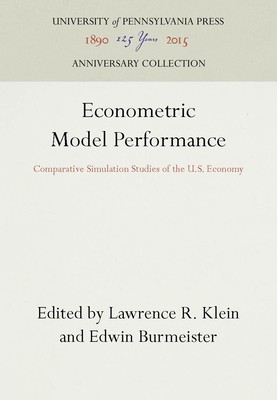
- We will send in 10–14 business days.
- Publisher: University of Pennsylvania Press Anniversary Collection
- ISBN-10: 0812277147
- ISBN-13: 9780812277142
- Format: 15.6 x 23.4 x 2.4 cm, hardcover
- Language: English
- SAVE -10% with code: EXTRA
Econometric Model Performance (e-book) (used book) | bookbook.eu
Reviews
Description
Models of the American economy exist in government, research institutes, universities, and private corporations. Given the proliferation, it is wise to take stock because these models come from diverse sources and describe different conditions from alternative points of view. They could be saying different things about the economy. The high-level comparative studies in this volume, gathered from several issues of the International Economic Review, with a substantive introduction and the addition of more comparative material, evaluate the performance of eleven models of the American economy: the Wharton Mark Ill Model; Brookings Model; Hickman-Coen Annual Model; Liu-Hwa Monthly Model; Data Resources, Inc. (DRI) Model; Federal Reserve Bank of St. Louis Model; Michigan Quarterly Econometric (MOEM) Model; Wharton Annual and Industry Model; Anticipation Version of the Wharton Mark Ill Model/Fair Model; U.S. Department of Commerce (BEA) Model.
Each of the proprietors or builders of these models describes his own system in his own words. These studies come closer than ever before to standardizing model operations for testing purposes. Some of the models are monthly, while others are annual. but the quarterly unit of time is the most frequent. Some are demand oriented, others are supply oriented, and focus on the input-output sectors of the economy. Some use only observed. objective data; others use subjective. anticipatory data. Both large and small models are included. In spite of the diversity, the contributors have cooperated to trace the differences between their models to root causes and to report jointly the results of their research. There are also some general papers that look at model performance from outside the CEME group.EXTRA 10 % discount with code: EXTRA
The promotion ends in 17d.01:28:25
The discount code is valid when purchasing from 10 €. Discounts do not stack.
- Publisher: University of Pennsylvania Press Anniversary Collection
- ISBN-10: 0812277147
- ISBN-13: 9780812277142
- Format: 15.6 x 23.4 x 2.4 cm, hardcover
- Language: English English
Models of the American economy exist in government, research institutes, universities, and private corporations. Given the proliferation, it is wise to take stock because these models come from diverse sources and describe different conditions from alternative points of view. They could be saying different things about the economy. The high-level comparative studies in this volume, gathered from several issues of the International Economic Review, with a substantive introduction and the addition of more comparative material, evaluate the performance of eleven models of the American economy: the Wharton Mark Ill Model; Brookings Model; Hickman-Coen Annual Model; Liu-Hwa Monthly Model; Data Resources, Inc. (DRI) Model; Federal Reserve Bank of St. Louis Model; Michigan Quarterly Econometric (MOEM) Model; Wharton Annual and Industry Model; Anticipation Version of the Wharton Mark Ill Model/Fair Model; U.S. Department of Commerce (BEA) Model.
Each of the proprietors or builders of these models describes his own system in his own words. These studies come closer than ever before to standardizing model operations for testing purposes. Some of the models are monthly, while others are annual. but the quarterly unit of time is the most frequent. Some are demand oriented, others are supply oriented, and focus on the input-output sectors of the economy. Some use only observed. objective data; others use subjective. anticipatory data. Both large and small models are included. In spite of the diversity, the contributors have cooperated to trace the differences between their models to root causes and to report jointly the results of their research. There are also some general papers that look at model performance from outside the CEME group.

Reviews